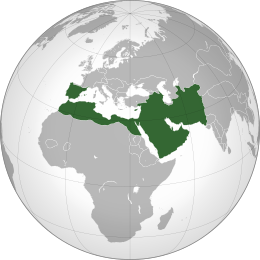Umayyad Caliphate (661–750): Difference between revisions
More languages
More actions
(Created) Tag: Visual edit |
m (Mode of Production for Umayyad Caliphate) Tag: Visual edit |
||
| Line 1: | Line 1: | ||
{{Infobox country|name=Umayyad Caliphate|native_name=ٱلْخِلَافَة ٱلْأُمَوِيَّة|capital=Damascus|government_type=Monarchy|life_span=661–750|image_map=Umayyad map.svg|map_width=260|map_caption=The Umayyad Caliphate in 750|religion=[[Islam]]|area_km2=11,100,000|area_footnote=(720)}} | {{Infobox country|name=Umayyad Caliphate|native_name=ٱلْخِلَافَة ٱلْأُمَوِيَّة|capital=Damascus|mode_of_production=Feudalism|government_type=Monarchy|life_span=661–750|image_map=Umayyad map.svg|map_width=260|map_caption=The Umayyad Caliphate in 750|religion=[[Islam]]|area_km2=11,100,000|area_footnote=(720)}} | ||
The '''Umayyad Caliphate''' was the second Islamic caliphate. [[Mu'awiya]], the cousin of the previous caliph [[Uthman]], founded the caliphate in 661 following the overthrow of the caliph [[Ali]] in a civil war. It remained in power for roughly a century and developed advanced [[agriculture]], urban crafts, banking, and culture.<ref name=":022">{{Citation|author=Neil Faulkner|year=2013|title=A Marxist History of the World: From Neanderthals to Neoliberals|chapter=The Medieval World|page=61–62|pdf=https://cloudflare-ipfs.com/ipfs/bafykbzacedljwr5izotdclz23o3c5p4di4t3ero3ncbfytip55slhiz4otuls?filename=Neil%20Faulkner%20-%20A%20Marxist%20History%20of%20the%20World_%20From%20Neanderthals%20to%20Neoliberals-Pluto%20Press%20%282013%29.pdf|publisher=Pluto Press|isbn=9781849648639|lg=https://libgen.rs/book/index.php?md5=91CA6C708BFE15444FE27899217FBA8E}}</ref> | The '''Umayyad Caliphate''' was the second Islamic caliphate. [[Mu'awiya]], the cousin of the previous caliph [[Uthman]], founded the caliphate in 661 following the overthrow of the caliph [[Ali]] in a civil war. It remained in power for roughly a century and developed advanced [[agriculture]], urban crafts, banking, and culture.<ref name=":022">{{Citation|author=Neil Faulkner|year=2013|title=A Marxist History of the World: From Neanderthals to Neoliberals|chapter=The Medieval World|page=61–62|pdf=https://cloudflare-ipfs.com/ipfs/bafykbzacedljwr5izotdclz23o3c5p4di4t3ero3ncbfytip55slhiz4otuls?filename=Neil%20Faulkner%20-%20A%20Marxist%20History%20of%20the%20World_%20From%20Neanderthals%20to%20Neoliberals-Pluto%20Press%20%282013%29.pdf|publisher=Pluto Press|isbn=9781849648639|lg=https://libgen.rs/book/index.php?md5=91CA6C708BFE15444FE27899217FBA8E}}</ref> | ||
Latest revision as of 13:09, 28 January 2023
| Umayyad Caliphate ٱلْخِلَافَة ٱلْأُمَوِيَّة | |
|---|---|
| 661–750 | |
 The Umayyad Caliphate in 750 | |
| Capital | Damascus |
| Religion | Islam |
| Dominant mode of production | Feudalism |
| Government | Monarchy |
| Area | |
• Total | 11,100,000 km²(720) |
The Umayyad Caliphate was the second Islamic caliphate. Mu'awiya, the cousin of the previous caliph Uthman, founded the caliphate in 661 following the overthrow of the caliph Ali in a civil war. It remained in power for roughly a century and developed advanced agriculture, urban crafts, banking, and culture.[1]
Economy[edit | edit source]
The Umayyads had a small ruling class that represented the original Arab warrior aristocracy who fought with Muhammad. They did not have to pay taxes and relied on tribute and war loot. They built palaces and spent lavishly on luxury goods and architecture.
Because Muslims were initially exempt from taxation, the state designated new converts as mawali and barred them from social advancement.[1]
Collapse[edit | edit source]
Abu al-Abbas, a descendant of Muhammad, built an underground resistance movement and became the leader of various dissident groups. He launched a revolution against the Umayyads and founded the Abbasid Caliphate in 750.[1]
References[edit | edit source]
- ↑ 1.0 1.1 1.2 Neil Faulkner (2013). A Marxist History of the World: From Neanderthals to Neoliberals: 'The Medieval World' (pp. 61–62). [PDF] Pluto Press. ISBN 9781849648639 [LG]
